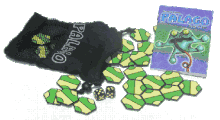Palago
Palago is a creative art puzzle/game designed by Cameron Browne and Mike McManaway (inventor of Tantrix). A Palago set contains 48 identical tiles which can be used for a series of puzzles, a strategic two player and a co-operative multi-player game (called Palagonia).
 Palago tiles | |
| Players | 1-5 |
|---|---|
| Setup time | 1 minute |
| Playing time | 30 minutes |
| Random chance | Medium |
| Age range | 6+ |
| Skill(s) required | Strategy, Artistic flair |
History
Cameron Browne, an Australian mathematician and author of two books on game theory, created the tile design and the two player version (originally called Lambo) in 2007. The named was changed to Palago, due to the resemblance of the tiles to the island of Palau and some strategic similarities to the game of Go. Browne proposed the concept of “Palagonia: A World of Shapes” to describe the many possible creature shapes that can be made with the tiles, several of which have been rendered as “Palagonian Puzzle Creatures” by Franco Giuliani, an Argentinian artist. The multiplayer version - also called Palagonia - was designed by McManaway and Browne in 2009, and uses all 48 tiles plus two specially designed “Palago” dice.
Gameplay
Palago
Both Palago and Palagonia can be played on any flat surface. To start Palago, each player chooses a colour and then draws a tile out of the bag to see who goes first (though having no significance in play, half the tiles have the colour of one player on the back and half have the colour of the other player).
The first player places two tiles in the middle with both colours matching. Play continues with each player always placing two tiles per turn, and obeying the basic rules.
Basic Rules:
- At least one of the two tiles must connect to the palago (the tiles already played).
- The two tiles being played must touch each other.
- All touching edge colours must match.
To win:
- The first player with a closed creature using more than three tiles of their colour is the winner.
- The creature must be closed on the inside too.
- Only one tile needs to be played, if that tile results in a win for either player.
- A player loses if they close creatures of both colours on the same move.
Palago can be played with any number of tiles. The game is drawn if the tiles run out before either player wins, (although with 48 tiles this is unlikely).
Palago is balanced between attacking and defending strategies. In fact, early in the game it can be wiser to defend without counter-attacking. This is because a player's overall position deteriorates with each attack while defending often seems to improve it. Then, when the timing is right, players should go on the attack and try to convert their superior position into a win.
Palagonia
All players roll one die to begin. (Palagonia uses 2 custom dice, the 2,3,4, and 5 are standard but have action symbols instead of the 1 and the 6). The player with the highest actual number (2,3,4, or 5) starts the game by taking exactly that number of tiles and connecting them together in any way (with colours matching). If nobody rolls a number, then all players roll again. Play then continues in a clockwise direction.
Each turn consists of the following steps:
- Roll both dice.
- Choose one to obey.
- Carry out that action.
The options depending on what you roll are to remove a tile, rotate a tile, or add new tiles to the board.
Basic Rules:
- When closing a creature, all tiles-to-be-played must form part of that creature or it does not score.
- If a player rolls doubles they get an extra turn.
- When one die action cannot be carried out, the other must be followed. If neither die action is possible, the player must remove an external tile.
Objective
Players score points by forming creatures. Larger ones are usually worth more, depending on their shape. The best way to close a high scoring creature is to team up with one of your neighbours (either the player just before you or just after you), because points are usually given to both players who contribute. The game ends when all the tiles have been used.
Additional information
Palago was officially launched at the 2010 Nuremberg International Toy and Game Fair and is currently available in these countries: New Zealand, Australia, Germany, Taiwan, Poland, Hungary, Croatia, Russia and Greece. It was chosen as one of the fair's top ten iconic images.
In September 2010, Palago won the New Zealand 'New Game of the Year' award.
References
- Nelson Mail review (NZ)
- Board Game Geek review (online)
- Palago player rankings (online)
- Yorktown This Week review (CAN)